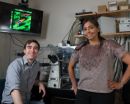(Press-News.org) When ovarian cancer spreads from the ovaries it almost always does so to a layer of fatty tissue that lines the gut. A new study has found that ovarian cancer cells are more aggressive on these soft tissues due to the mechanical properties of this environment. The finding is contrary to what is seen with other malignant cancer cells that seem to prefer stiffer tissues.
"What we found is that there are some cancer cells that respond to softness as opposed to stiffness," said Michelle Dawson, an assistant professor in the School of Chemical and Biomolecular Engineering at the Georgia Institute of Technology. "Ovarian cancer cells that are highly metastatic respond to soft environments by becoming more aggressive."
Ovarian cancer cells spread, or metastasize, by a different method than other cancer cells. Breast cancer cells, for example, break off from a solid tumor and flow through the blood until they arrest in small blood vessels. The cancer cells then penetrate the vessel surface to form a tumor. Because ovarian tumors are in the abdomen, these cancer cells are shed into the surrounding fluid and not distributed through the blood. They must be able to adhere directly to the fatty tissue that lines the gut, called the omentum, to begin forming a tumor. The new study discovered details about how ovarian cancer cells seem to prefer the mechanical properties of this soft tissue.
The study was published in a recent advance online edition of the Journal of Cell Science and was sponsored by the National Science Foundation and the Georgia Tech and Emory Center for Regenerative Medicine.
The research team, led by Daniel McGrail, a graduate student in the Dawson lab, found that ovarian cancer cells in vitro were more adherent to a layer of soft fat cells than a layer of stiffer bone cells, and that this behavior was also repeated using gels of similar rigidities.
"All the behaviors that we associate with breast cancer cells on these more rigid environments are flipped for ovarian cancer cells," Dawson said.
After adhering to these soft surfaces, metastatic ovarian cancer cells became more aggressive. Their proliferation increased and they were less responsive to chemotherapeutics. The ovarian cancer cells were also more motile on soft surfaces, moving nearly twice as fast as on rigid surfaces.
The team also found that less aggressive cells that do not metastasize do not exhibit any of these changes.
The researchers used techniques that haven't been traditionally used in the study of ovarian cancer. They measured the force exerted by the cells by tracking the displacement of beads in the environment around the cells. The researchers found that the metastatic cells increased their traction forces – used to generate motion – by three-fold on soft surfaces, but no such change was present in the less aggressive cells.
"We think the behavior that metastatic ovarian cancer cells exert on these soft surfaces is representative of the mechanical tropism that they have for these softer tissues in the gut," Dawson said.
In future work, the researchers will investigate whether ovarian cancer cells have some natural inclination towards this uniquely more aggressive behavior in softer environments.
"We're trying to find out whether there is some internal programming that leads to this aggressive behavior," Dawson said.
INFORMATION:
This research is supported by the National Science Foundation under award number 1032527, and the Georgia Tech and Emory Center for Regenerative Medicine under award number 1411304. Any conclusions or opinions are those of the authors and do not necessarily represent the official views of the sponsoring agencies.
CITATION: Daniel J. McGrail, et al., "The malignancy of metastatic ovarian cancer cells is increased on soft matrices through a mechanosensitive Rho-ROCK pathway." (Journal of Cell Science, 2014). http://dx.doi.org/10.1242/jcs.144378
Ovarian cancer cells are more aggressive on soft tissues
2014-05-08
ELSE PRESS RELEASES FROM THIS DATE:
Army drug users twice as likely to use synthetic marijuana as regular marijuana
2014-05-08
Social work researchers from the University of Washington have found that among a group of active-duty Army personnel who use illicit drugs, the most abused substance is synthetic marijuana, which is harder to detect than other drugs through standard drug tests.
The research will be published in the July 2014 issue of Addictive Behaviors, but is already online.
Synthetic marijuana, sometimes called "Spice," is made with shredded plant material coated with chemicals that are designed to mimic THC, the psychoactive compound found naturally in marijuana. The U.S. Drug ...
Single cell genome sequencing of malaria parasites
2014-05-08
SAN ANTONIO, May 8, 2014 – A new method for isolating and genome sequencing an individual malaria parasite cell has been developed by Texas Biomed researchers and their colleagues. This advance will allow scientists to improve their ability to identify the multiple types of malaria parasites infecting patients and lead to ways to best design drugs and vaccines to tackle this major global killer. Malaria remains the world's deadliest parasitic disease, killing 655,000 people in 2010.
Malaria parasite infections are complex and often contain multiple different parasite genotypes ...
New genomics technique could improve treatment and control of Malaria
2014-05-08
Single-cell genomics could provide new insight into the biology of Malaria parasites, including their virulence and levels of drug resistance, to ultimately improve treatment and control of the disease, according to new research funded by the Wellcome Trust and the National Institutes of Health.
The findings are revealed in a study by researchers at the Texas Biomedical Research Institute and published today in the journal Genome Research.
Malaria infections commonly contain complex mixtures of Plasmodium parasites which cause the disease. These mixtures, known as multiple ...
Open science journal publishes attempt to reproduce high-profile stem cell acid bath study
2014-05-08
In a study published today in F1000Research, Professor Kenneth Lee of the Chinese University of Hong Kong reveals the full experimental results of an attempt to replicate a controversial study published in Nature recently that suggested that bathing somatic cells in acid can reprogram them to induced pluripotent stem cells (iPS cells). With systematically collected and fully available data, Lee and his colleagues report that carefully replicating the original acid-treatment method does not induce pluripotency in two types of mouse somatic cells, including those used in ...
NASA sees system 90E moving toward southwestern Mexico
2014-05-08
A tropical low pressure area known as System 90E is located a couple of hundred miles southwest of Zihuatenejo, Mexico today and was seen by NASA's Terra satellite on its way to a landfall.
The Moderate Resolution Imaging Spectroradiometer (MODIS) instrument aboard NASA's Terra satellite captured a visible image of System 90E on May 7 at 18:50 UTC/ 2:50 p.m. EDT as it headed to a landfall in southwestern Mexico. The low appeared disorganized as it approached the southwestern coast of Mexico near the states of Michoacan and Guerrero.
According to NOAA's National Hurricane ...
Recycling a patient's lost blood during surgery better than using banked blood
2014-05-08
Patients whose own red blood cells are recycled and given back to them during heart surgery have healthier blood cells better able to carry oxygen where it is most needed compared to those who get transfusions of blood stored in a blood bank, according to results of a small study at Johns Hopkins.
In a report for the June issue of the journal Anesthesia & Analgesia, the researchers say they found that the more units of banked blood a patient received, the more red cell damage they observed. The damage renders the cells less flexible and less able to squeeze through a ...
Few women at high-risk for hereditary breast and ovarian cancer receive genetic counseling
2014-05-08
Mutations in the BRCA1 and BRCA2 genes account for nearly 25 percent of hereditary breast cancers and most hereditary ovarian cancers, yet a study by cancer prevention and control researchers at Virginia Commonwealth University Massey Cancer Center suggests an alarmingly small amount of women who qualify for BRCA genetic counseling actually receive the services. Additionally, they found that a significant proportion of women with a family history of breast and ovarian cancer underestimate their own risk.
The study, published in the April edition of the Journal of Community ...
Anti-aging factor offers brain boost too
2014-05-08
A variant of the gene KLOTHO is known for its anti-aging effects in people fortunate enough to carry one copy. Now researchers find that it also has benefits when it comes to brain function. The variant appears to lend beneficial cognitive effects by increasing overall levels of klotho in the bloodstream and brain.
What's more, the improvements in learning and memory associated with klotho elevation aren't strictly tied to aging. They do occur in aging mice, but also in young animals, according to a report published in the Cell Press journal Cell Reports on May 8th. ...
What vigilant squid can teach us about the purpose of pain
2014-05-08
Most of us have probably felt that lasting sense of anxiety or even pain after enduring some kind of accident or injury. Now, researchers have the first evidence in any animal that there may be a very good reason for that kind of heightened sensitivity—or at least there is in the battle of squid versus fish. Squid that behave with extra vigilance after experiencing even a minor injury are more likely to live to see another day, according to a report appearing in the Cell Press journal Current Biology on May 8.
The findings suggest that behaviors that appear counterproductive ...
Antibiotic resistance genes are essentially everywhere
2014-05-08
The largest metagenomic search for antibiotic resistance genes in the DNA sequences of microbial communities from around the globe has found that bacteria carrying those vexing genes turn up everywhere in nature that scientists look for them. The findings reported in the Cell Press journal Current Biology on May 8 add to evidence showing just how common and abundant those resistance genes really are in natural environments.
This big-picture, ecological view on a growing healthcare concern emphasizes the important relationship between antibiotic resistance in the clinic ...

